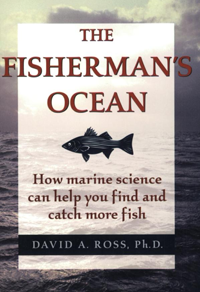The following excerpt is from the book The Fisherman’s Ocean by David A. Ross, Ph.D. Reprinted with permission from Stackpole Books, Mechanicsburg, Pennsylvania.
[dropcap]T[/dropcap]he high visibility of conventional monofilament fishing line has led to an increased use by many anglers of an alternative, especially for fly-fishing leaders or shock tippets—fluorocarbon line. Visibility of line in water is determined by how close the line’s index of refraction is to the 1.33 refractive index of water; the closer it is to this number, the less visible the line. Fluorocarbon line has a refractive index of 1.42, while conventional, nylon-based monofilament has an index of around 1.55. This difference, although small, makes for a considerable visibility decrease in fishing situations.Fluorocarbon line has several other positive features. It’s denser than conventional monofilament and therefore sinks faster, and because of its increased density it is also more resistant to abrasion. Also, nylon monofilament absorbs water, and fluorocarbon does not. This means the fluorocarbon line will maintain its breaking strength in water, whereas nylon monofilament can lose 10 to 15 percent of its strength when wet. Fluorocarbon line also holds up much better to ultraviolet rays, showing no changes after considerable exposure to direct UV light, while conventional monofilament can loose over 30 percent of its strength and change color after only a modest exposure to UV light.
On the negative side, fluorocarbon line is too stiff to be effectively used as actual fishing line and can be difficult to knot. It is, however, good leader material, both for commercial fishermen and for fly or light-tackle enthusiasts. You should carefully test any knot tied in fluorocarbon line, especially when joining lines of different diameters. I lost some nice fish before I learned to be more careful about tying knots with fluorocarbon line.
The main reason why fluorocarbon is not more popular among anglers is that it costs considerably more than conventional monofilament line. It may be worth the price when you’re fishing for species that have good vision, such as tuna, little tunny, and bonito. Most major fishing-line manufacturers offer fluorocarbon line, and competition and/or improved production methods should make it less stiff and lower the price in the future.
In next Wednesday’s Fish Facts Ross explains more about fish SENSES and how to apply them to improve your fish-catch stats.



